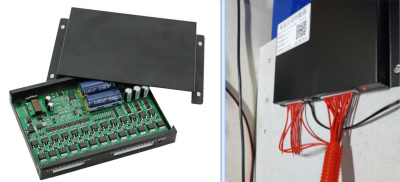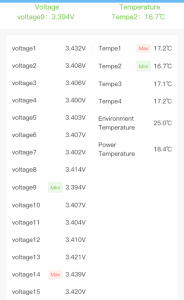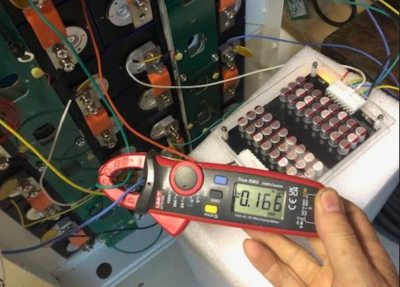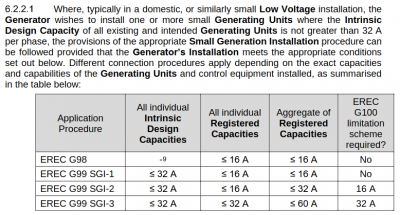Posted by: @transparentActive balancers don't operate at the kilohertz range.
Their micro-controller takes time to measure the cell voltages and decide which is the highest and lowest in the set.
To do so it first switches off the current flow on all balance leads.
(Sorry if this comes across as picky; I felt people might find this video interesting)
Stuart Pittaway's analysis of a (somewhat broken) active balancer reveals an interesting design that does not involve cell voltage measurement.
I'll have to think a bit about the balancing method.
I'm not familiar with the Active-Balancer you're using.
The ones I have here are the larger/newer version, albeit from the same manufacturer Jikong/Neey
As you can see, the strategy is quite different.
My version has just two large capacitors and a ladder network of mosFET switches to connect them across the separate cells.
Save energy... recycle electrons!
The spec of the one I have is 100mOhms, and I can read on it the cap values it uses - they are 3x 6.3V 2200uF per channel. The total charge transferred per period will then be:
Q=C.(V2-V1) = C.DV where DV=DeltaV, voltage between a pair of cells (say in a 2 cell system)
Q = Iav.t, where the time in question is 1/f, where f is the operating frequency . Appreciate I will not be flat, but we don't care about that, we just want the average not the actual waveshape.
so Iav = C.DV.f
As R=DV/Iav then:
R = 1/C.f)
or f = 1/(R.C)
So in this case, C=6.6mF, R = 0.1Ohms, so the calculated f = 1/(0.1*6.6E-3) = 1.5kHz
I hadn't worked this out before, but there's going to be a compromise between component cost (capacitance cost is significant) and static power loss (which will increase with operating frequency) for a given output impedance going on, so it was an informed guess.
Maybe I'll measure it - but not while it's connected to a massive battery in case my probe slips 🙂
As for the polyfuse - they're only there to protect the wires in the event the active balancer pcb is completely toast. They can do that - in fact I just tried one with a weedy bit of wire across an old car battery, and it just tripped straight away, the thin bit of wire didn't even feel hot. Maybe there's some other fault condition, but I think this covers the most worrying - pcb/mosfet short circuit otherwise making the copper wire 100s of C, smoking PVC insulation, horribleness.
Our battery is almost charged now - It's had 2A continuously for 4 days, so about 200Ah going into each cell. Now they are fuller, discrepancies are showing as the cells are at the steep end of their voltage:SOC curve:
Cell 14 is the highest voltage, 45mV above the lowest, cell 9. I have a dc clamp on meter, that can measure down 1mA dc - it does drift off by 10mA over a few minutes, but can be reset. Clamping onto the bms wires left and right of a cell will show the bms current overall to the cell - note the wires go through the clamp in different directions, we want to find Icellpositive - Icellnegative. If the clamp fitted on the busbar it would be simpler - then I'd measure every cell current directly.
Cell 14 has 166mA being removed from it by the bms
Cell 9 has 140mA being added to it by the bms
That's a 306mA difference in charge current between the two cells that have a 45mV discrepancy, or 45mV/306mA = 147mOhms, which matches well with the expected BMS resistance.
I intend to leave it like this for "a while", see how well they pull together while I figure out what to do with the inverter.
In the end it took 5 days to charge at 2A, so about 250Ah went into each cell. When the cells are charged, any variation appears, and it took another 12 hours for the variation in cell voltages to reduce - down to 3.496 to 3.498V as measured by the Seplos controller. So I took off the extra balancer, and tightened all the bolts up with a torque wrench. There’s some pvc tape wrapped around the torque wrench - don’t want any nasty shorting surprises!
or anyone.
Hi I have been looking everywhere for information such as this to help me work through the G99 fast track application, my understanding is the 8kw has to be submitted under the G99 rules but can be fast tracked as compliant and also as G100 feed limited also falls under advice and notify criteria rather than apply for permission, but that bits not as important as asking if anyone can help me with tips re the following.
So, working through this I see it was some time ago that you @transparent did this application, I have a Sunsynk eco 8k both G98 and G99 compliant and has all the registration required and wondered if you remember what you entered in key sections of the form.
With the National grid application form I obviously submit the relevant compliance details and line plans however in the section and i quote
"Details of Export Limitation Scheme
Where an export limitation scheme is required by SGI-2 or SGI-3 please
state export limit setting in amps."
form link below,
Q1
I assume i enter 16amps? although as we know the inverter can produce 32Amps but is limited by export settings as required under G100 🙂 ?
Q2
The other question is as I have 30kw of storage although as required under the fast track system its managed by the inverter and therefore compliant how does this effect my application.
Q3
As i have 20 potential KW of solar dc power the max for the unit at 8800w do i show this on my diagrams?
Sorry to be so dumb I just dont wish to apply and find i got it all wrong.
Q4.
DO i have to do the additional limitation form they reference.
If it was not for the uK weather id be tempted to be off grid avoiding all of this but its not viable in our climate.
Any advice on the form sections completion appreciated.
Relevant form.
Many thanks in advance,
Skipster.
Here's a section from the G99 specification which is available from the ENA website,
The Sunsynk 8k inverter has inbuilt current limiting to 16A (3.68kW) and therefore falls within SKI-2.
Posted by: @skippyI have 30kw of storage although as required under the fast track system its managed by the inverter and therefore compliant how does this effect my application.
As i have 20 potential KW of solar dc power the max for the unit at 8800w do i show this on my diagrams?
You can show these figures, but they're irrelevant to the G99 application process.
G99 is only assessing the amount that can be exported to the grid.
What capacity of solar panels and battery storage you have, will make no difference.
Remember that the form is being read by a human with common sense.
Once you've stated the model number of the Sunsynk inverter, they'll be able to see on the ENA database what current limitation is inbuilt.
Save energy... recycle electrons!
Thanks.
That confirmed my thoughts and appreciated
Application and documents sent and will report back when I hear something.
New member here - looking for some help on this subject. I'm installing a Seplos Mason battery and need to select a suitable G98 certified inverter/charger to use. I will not be installing PV so a hybrid inverter is overkill for this application.
I was hoping to use the Solis unit noted at the start of this thread but it doesn't appear to be certified. What is everyone else using with their battery only systems ?
(Just to make things more complex I live in Northern Ireland which further reduces my options, potentially to zero)
Hi @alphonsox - you're welcome here, whether you use Irish electrons or British ones.
Why do your options equate to zero potential?
1: If you're not going to be generating electricity within your property (solar or otherwise), then can we assume that you won't be wanting to export back to the grid?
And if that's the case, then you don't have to buy an inverter certified to G98.
The EREC G-standards apply to sites which supply the grid.
You would still require a G98 inverter if it was to be supplying your home in parallel with the grid,
but not, for example, if it were used to run a heat-pump in an "off-grid" configuration.
2: And if Assumption-1 is true, then can we also assume that your storage battery is for electricity to be used within the house?
If so, then there are two possible reasons for installing a battery:
a. You will use a Time-of-Use (ToU) tariff to charge the battery when electricity is cheaper
b. You want to have electricity when there is a power-cut
... or both.
For the moment feel free to stick with non-technical explanations of what you'd like to achieve.
We can fill in the kWh and £s later on.
Save energy... recycle electrons!
@transparent Thanks for the quick response.
This is a pure money saving exercise exploiting ToU. The house is currently running on E7 and I want to minimise my peak consumption by charging the battery overnight and discharging during the day. I don't have an issue with power-cuts here so I expect to use a grid coupled solution with no islanding required. My expectation is that the battery would supply the first 16A of load with the grid only being called on if the house load exceeds this. Clearly no export is needed or desired.
OK. Understood. So you will require a G98 certified inverter because it's grid-tied.
And you'll want one with a Current Transformer (CT) which is configured to prevent all export.
Whatever is stored in the battery will only get used within your house.
Have you considered a SunSynk 'Bi-directional' inverter?
They are designed to permit no export to the grid by default.
Moreover that export-limitation mechanism already has approval by the ENA (Electrical Networks Association).
So you could opt for an inverter model with greater output than 16A, and still be granted approval from your DNO (which in your case is NIEN).
You can verify this by applying online for G99F/T (Fast Track) permission, and stating a particular SunSynk model.
G99 applies to combined storage and export, and is explained more fully on that website.
You don't then have to install that model. You can change your mind and apply again.
But at least that will give you an idea of any 'issues' which the DNO thinks might apply to your particular site.
Save energy... recycle electrons!
- 26 Forums
- 2,378 Topics
- 53.9 K Posts
- 236 Online
- 6,060 Members
Join Us!
Worth Watching
Latest Posts
-

RE: Solar Power Output – Let’s Compare Generation Figures
Next house? After all that renovation, don't tell me ...
By Majordennisbloodnok , 2 hours ago
-
RE: Testing new controls/monitoring for Midea Clone ASHP
As somebody with 30 years professional experience in co...
By Mosibi , 2 hours ago
-
@f1p Looks good, and will likely be something I use whe...
By Sheriff Fatman , 2 hours ago
-
RE: Radiator sizing sanity check
@jamespa Thanks, yes. I think there are multiple har...
By Papahuhu , 2 hours ago
-
RE: Grant ASHP 17.5 kw. weather curve
sorry WC weather comp. so when you say tweak up to inc...
By Chinkoa , 2 hours ago
-
RE: Cascade 2x Grant Areona 10kw ASHP - Ongoing setup issues
Either complete Bow Locks or at best a marginal effect....
By JamesPa , 5 hours ago
-
Hi all I’m looking to get some insight on what others...
By Renewables345 , 5 hours ago
-

RE: The Great British Heat Pump Owner Persona Survey: Let's Build Our Archetype!
@mosibi, go on then, complete the survey. Let's get the...
By Mars , 6 hours ago
-
RE: Water Hammer After Heat Pump Install
@jaynieq I wish you luck with this one. I think the ma...
By JamesPa , 8 hours ago
-
RE: Optimum new build house design for Heat Pump
From first principles I would say: Definitel...
By JamesPa , 23 hours ago
-

RE: Weather compensation- why you should use it
As good a place as any to drop this video:/p>
By Mars , 1 day ago
-
RE: Forum updates, announcements & issues
@transparent D'Oh - I did look before I posted but I mi...
By dr_dongle , 1 day ago
-
Compatibility with Samsung AE080RXYDEH
I am new to all this. We have a SamsungAE080RXYDEH that...
By John999 , 1 day ago
-
RE: New Fogstar 15.5kWh upright solution
@batpred Maybe you should buy your additional batter...
By Bash , 1 day ago
-

RE: Data Accuracy Problem: Daikin 8kW Heat Pump's Onecta App vs MMI Power Consumption
@nursethescreens Yes, comfort and happiness of the fami...
By Toodles , 1 day ago
-
RE: Connecting Growatt SPH5000 over wired ethernet rather than wireless
Thanks folks. I had tried googling an ethernet lab adap...
By z8lccda , 2 days ago
-
RE: Changing from 4-port buffer to volumizer
@toodles I'm not concerned that the behaviour is not no...
By Andy1618 , 2 days ago
-

-

RE: Setback savings - fact or fiction?
I agree, and I think there are two things in play here....
By cathodeRay , 2 days ago
-
RE: Help needed with Grant Aerona 3 issues
First time posting so bear with me. Some bits that have...
By Adamp , 3 days ago









